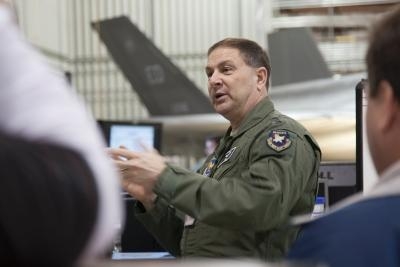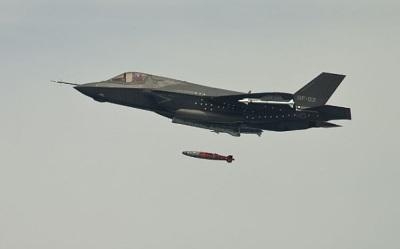Lt. Gen. Christopher C. Bogdan Admits The Program Has Had A Rocky Road
The F-35 Lightning II joint strike fighter program is a different program than it was four years ago, the F-35 program executive officer said March 12 in a speech at the McAleese/Credit Suisse Defense Programs Conference at the Newseum in Washington, D.C. Lt. Gen. Christopher C. Bogdan told attendees that he and his predecessor, Navy Vice Adm. Dave Venlet, worked with Lockheed-Martin and Pratt & Whitney to reform the problem-plagued development program.

"Lockheed-Martin and Pratt & Whitney have been doing a pretty good job over the last few years of stepping up and making those kinds of changes that the government needs for this program to succeed," the general said.
The aircraft's development has been rocky, Bogdan (pictured) acknowledged. A redesign of the short takeoff and vertical landing system in 2004 led to delays and added $6 billion to the cost of the development program, he said. "Then, in 2009, we somehow managed to drive the train off the tracks on this program," Bogdan said.
The program breached the Nunn-McCurdy Act, which requires that programs exceeding certain parameters in costs and scheduling appeal to Congress to avoid cancellation. Venlet led the program through the appeal process, the general said, and "basically gave us a great gift." The appeal led to an extra 30 months being tacked onto the development schedule and provided $6 billion in additional development funds. "Anybody that gets three more years and $6 billion better be able to get a program across the finish line," Bogdan said.
Since then, he said, the program has been making slow and steady progress and is on track, particularly for two significant deadlines -- 2015, when the Marine Corps is scheduled to have combat-ready aircraft; and 2017, when development is scheduled to end. "Those two dates are extremely important," Bogdan said. "If I don't get to those two dates or I don't reach the finish line there, then we will continue to produce airplanes that don't have the capability that the warfighter needs."
Some of the program changes have been painful, the general said, but were necessary. For example, until 2010 the program was operating without an integrated master schedule, so it was difficult to track the systemwide effects of a change in any part of the program. The schedule has been built, and now tracks about 16,000 items, he said. It's a small thing that makes a big difference in how a program is managed, he noted. "We can actually track each of those events and see how they affect the end timeline," Bogdan said.

His predecessor introduced a more radical change in the engineering process, the general said. Previously, design reviews were conducted by the program office, he said. "Well, I have a good program office, but I don't have the resources, nor do I have the expertise that the entire Department of Defense has when it comes to building airplanes," Bogdan said.
Design review boards are now chaired by government executives from throughout the Defense Department who are seasoned engineers with experience developing successful aircraft programs, he said. "And they draw on the expertise of all the people underneath them at those organizations to help us decide, technically, 'Are we ready to move forward?'" he added, noting that the change has paid great dividends.
The general said the program's affordability is his leading concern. The development program ends in 2017, he said, and is about 90 percent complete, with about $6 billion left in the budget. "That last 10 percent is the real hard 10 percent," Bogdan said. "So, what I have told the enterprise is, relative to development, we have no more time, and we have no more money." This requires a change in mindset, the general said. Additional expenses have to be offset by a reduction elsewhere, and that, he said, may mean a reduction in end capability. "That has profound implications for the warfighter. I can honestly tell you that the warfighter does not like me standing up saying that," Bodgan said.

F-35 production is "the shining star" of the program, the general said. About 30 aircraft are being built each year, he said, and the cost per unit has come down with each successive low-rate initial production, or LRIP, lot. Between LRIP 4 and LRIP 5, there was a 4-percent decrease in build costs, Bogdan said, a trend he said he believes will continue until per-unit costs approach the original 2001 estimate of $69 million. "I think we can get there," he said. "Lockheed-Martin and Pratt & Whitney are doing a pretty good job of coming down that cost curve. They're getting more efficient in their production line [and] their quality is going up, ... and that is a good thing, because I promise you the one thing that our partners care most about is how much this airplane's going to cost."
Eight nations have committed to participate in the development program, and another three may buy F-35s, with nearly 3,000 aircraft expected to be produced. With such a large order and so many partners invested in the aircraft, it's essential to keep costs down to avoid what Bogdan called the "death spiral," something he said he's seen kill off many programs. The death spiral is when increasing costs lead to a reduction in the number of units purchased, which in turn leads to further per-unit cost increases, and so on. "I don't think that's the fate of this program," Bogdan said. "But the proof is in the pudding, and we have to continue to see Lockheed-Martin and Pratt & Whitney investing in making the production line more efficient, squeezing the costs out, and getting the unit cost of this airplane down. I think they can do it, but we have to wait and see."
Production costs are only part of the puzzle, however. About 70 to 80 percent of any program's costs are in the long-term operation and sustainment phase, the general said. What's unique about the F-35 is that the Defense Department has never had to estimate the costs of a 50-year aircraft life cycle, he said. Adding to the complications of producing such a cost estimate is that the department hasn't had an aircraft program this large since World War II, Bogdan said. "So, lots of airplanes over a very long period of time, with inflation added in, you can understand how the (Office of the Secretary of Defense) guys come up with a number like $1.1 trillion," he said. "That's an astronomical number; it's based on a lot of assumptions. I'm not saying that that's a bad number; I'm just saying we need to take that number with a grain of salt."
Bogdan summarized his expectations. "We are trying to instill a level of discipline in this program such that there are no surprises -- we have predictable outcomes (and) when we have problems, we have ways of solving those problems," he said. "(This is) very hard to do on a very big, complex program that has lots and lots of decision-makers (and) lots and lots of pots of money, but I think that's an absolute necessity to get the program moving in the right direction."
(USAF, U.S. Navy Images)
 ANN's Daily Aero-Linx (04.15.24)
ANN's Daily Aero-Linx (04.15.24) Classic Aero-TV: 'No Other Options' -- The Israeli Air Force's Danny Shapira
Classic Aero-TV: 'No Other Options' -- The Israeli Air Force's Danny Shapira Aero-News: Quote of the Day (04.15.24)
Aero-News: Quote of the Day (04.15.24) Airborne 04.16.24: RV Update, Affordable Flying Expo, Diamond Lil
Airborne 04.16.24: RV Update, Affordable Flying Expo, Diamond Lil ANN's Daily Aero-Term (04.16.24): Chart Supplement US
ANN's Daily Aero-Term (04.16.24): Chart Supplement US





